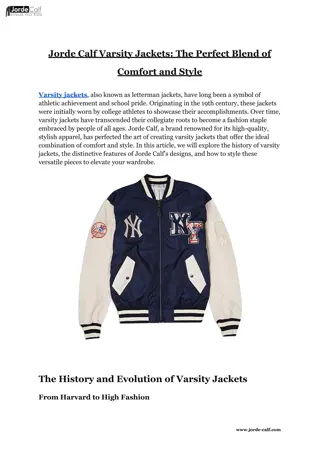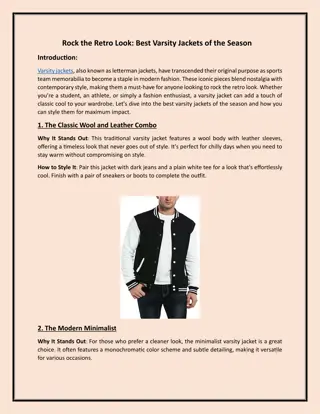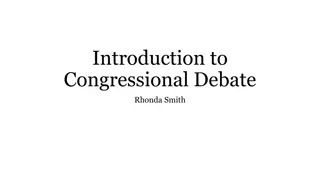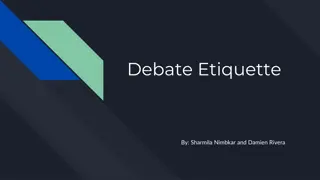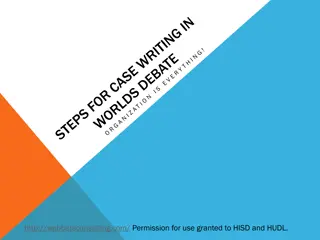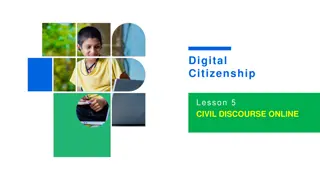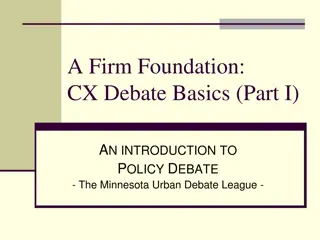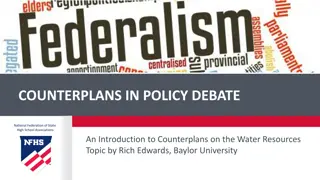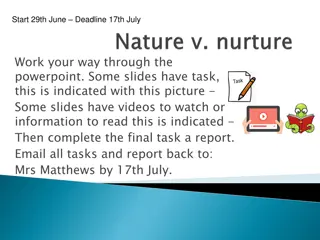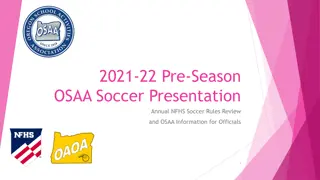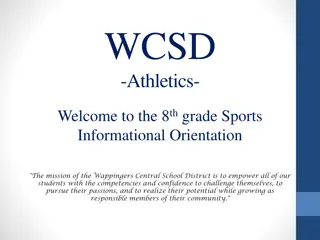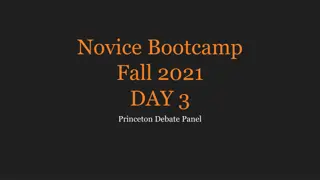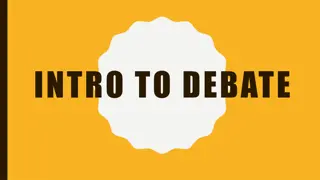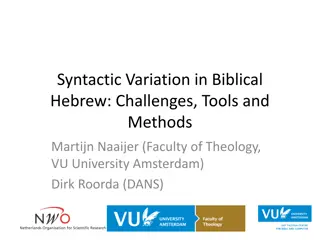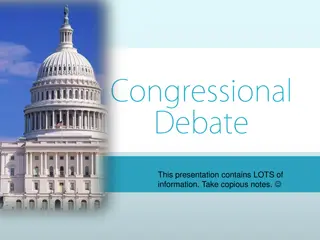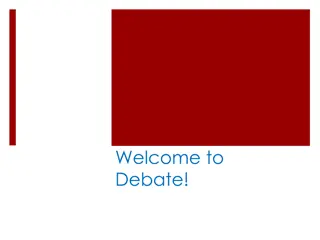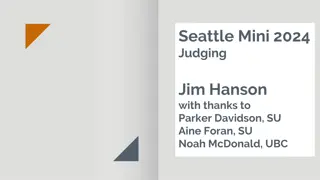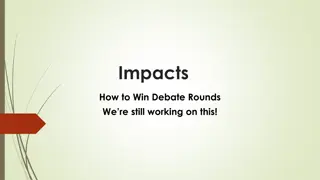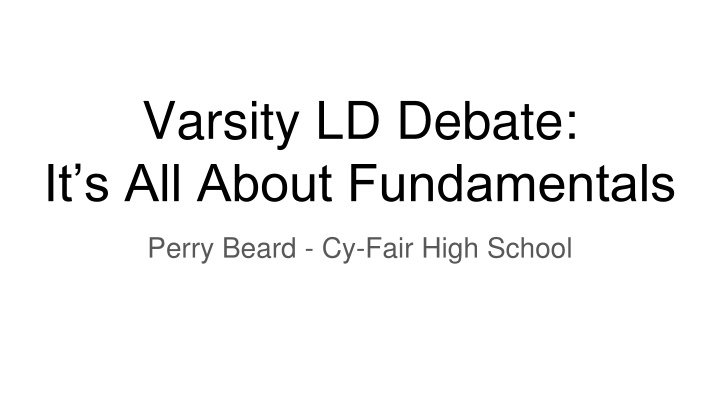
Mastering Fundamentals of Varsity LD Debate
Dive into the essential aspects of Varsity LD Debate with a seasoned Speech & Debate Coach, focusing on refutation, weighing, and value clash. Understand the three-round burst strategy to deconstruct arguments effectively. Explore practical examples to enhance your debating skills.
Download Presentation

Please find below an Image/Link to download the presentation.
The content on the website is provided AS IS for your information and personal use only. It may not be sold, licensed, or shared on other websites without obtaining consent from the author. If you encounter any issues during the download, it is possible that the publisher has removed the file from their server.
You are allowed to download the files provided on this website for personal or commercial use, subject to the condition that they are used lawfully. All files are the property of their respective owners.
The content on the website is provided AS IS for your information and personal use only. It may not be sold, licensed, or shared on other websites without obtaining consent from the author.
E N D
Presentation Transcript
Varsity LD Debate: It s All About Fundamentals Perry Beard - Cy-Fair High School
A little bit about me... I just finished my 20th year in education and my 19th year as a Speech & Debate Coach. 2006 & 2007 5A UIL State Champion coach in LD Coached the 2011 state champion, the 2010 runner-up and the 2016 3rd place finisher in LD at TFA State. 2011 NSDA National Champion coach in LD and coached a top 15 finisher in 2016. LD was not my best event in high school, but it was and still is my favorite!
What am I not going to talk about... CX arguments in LD (plans, disads, counterplans) Critical arguments, or kritiks Debate Theory, or debate about debate
What I am going to discuss... 1. Refutation 2. Weighing 3. Value clash
Refutation - defined as the action of proving a statement or theory to be wrong or false. Let s talk about military grade assault rifles for a moment .
Single Shot - excellent if you are highly accurate, but if you miss your mark then you don t take down the target Fully Automatic - very effective in using lots of rounds to blast an area, but not very accurate. If you hit the target, you might only wing them. Three-Round Burst - Three shots in rapid succession fired accurately in the same general area. This setting on a military issued assault rifle is considered the most effective means of taking down a target.
In LD Debate, Ive found that there is a three-round burst that a debater can use to take down almost every argument. 1. The argument is NOT TRUE 2. arguments ir more important than my opponent s argument. The argument DOESN T MATTER because one of my 3. the debater is trying to achieve, or it TURNS the argument. The argument actually makes things worse for what
EXAMPLE Nov/Dec 2016 NSDA LD Resolution: RESOLVED: The United States ought to limit qualified immunity for police officers.
Affirmative Argument: Limiting Qualified Immunity for police officers helps minimize or solve for police brutality and/or racism. NEG Response #1 - NOT TRUE: Limiting Qualified Immunity only means more civil trials against police officers go forward; does not prove that the trial will be in the favor of the plaintiff.
Affirmative Argument: Limiting Qualified Immunity for police officers helps minimize or solve for police brutality and/or racism. NEG Response #2 - DOESN T MATTER: Even if plaintiff s win against officers in court, legal action really does not spur any sort of reform in police departments
Affirmative Argument: Limiting Qualified Immunity for police officers helps minimize or solve for police brutality and/or racism. NEG Response #3 - TURN: Limiting qualified immunity causes racism to fester and grow. Assuming that limiting qualified immunity will solve for all sorts of social ills is actually more harmful because it makes everyone think that those problems are solved. Just because you can sue a police officer for racist conduct does not mean that racism is solved.
Defense vs. Offense Debate is just like Football. You only win if you score more points than your opponent. You can only win when you are on offensive plays. You can t win only by making only defensive stops. This is why defenses in football that generate turnovers like interceptions and fumble recoveries are so valuable. They are defenses that generate offensive plays.
Defense vs. Offense The first two responses, NOT TRUE and DOESN T MATTER are defensive arguments. They keep the opponent from advancing the ball. They do not score the debater making those responses any points. You still need to get the ball across the goal line. TURNS are great because they are OFFENSIVE arguments. Often, they can be tailored in round to take out an opponent s value, criterion, or both. Address TURNS first when you are refuting these kinds of arguments. Extend TURNS when your opponent fails to address them adequately.
Negative Argument: Limiting Qualified Immunity leads to under-policing and deterring police officers from action AFF Response #1 - NOT TRUE: Evidence is completely speculative; no hard data to prove police won t act, [This response is purely DEFENSIVE]
Negative Argument: Limiting Qualified Immunity leads to under-policing and deterring police officers from action AFF Response #2 - DOESN T MATTER: Police officers do the job because they feel that it is a calling or part of their identity. They understand that enforcing the law is their job and are likely to continue doing so. [This response is purely DEFENSIVE]
Negative Argument: Limiting Qualified Immunity leads to under-policing and deterring police officers from action AFF Response #3 - TURN: When police officers are NOT being held accountable, it will cause people to lose faith in the institutions of justice and the courts, making it more likely that civil unrest will happen in the world of the Negative, such as in Ferguson, MO after Michael Brown was shot and killed by a police officer [OFFENSIVE -good to TURN a value of Societal Welfare]
STICKY NOTES AND FOLDERS Two manila folders Two stacks 1.5 x 2 inch Post-It Notes One red pen One blue or black pen One folder is AFF RESPONSES to NEGATIVE ARGUMENTS The other folder is NEG RESPONSES to AFFIRMATIVE ARGUMENTS
STICKY NOTES AND FOLDERS Using the AFF RESPONSES to NEGATIVE ARGUMENTS folder, have the debater place about 10-12 Post-its evenly spaced throughout one inside portion of the folder. Make sure the notes are longways with the adhesive to the side. In the space above each Post-It, write a Negative argument in RED. On the Post-It below the argument, write (in very small and abbreviated form) the three responses in BLUE or BLACK. When the debater is AFF and hears one of the NEG arguments that they have prepped out, they can easily place the response on their flowsheet.
WEIGHING When comparing arguments, especially those arguments that are utilitarian or consequentialist arguments, how does the judge know which one is best? THE DEBATER TELLS THEM WHICH ONE IS BEST!
WEIGHING Three Types of Weighing 1. Magnitude 2. Timeframe 3. Probability
MAGNITUDE (nuke war or Ebola outbreak) Weighing impacts by magnitude means to evaluate how large and significant that impact will be. Usually, this involves the number of people affected by the results of a particular advocacy. For most debaters, it usually means how many people are hurt or killed in the world of their opponent and how they can prevent or avoid it in the world of their side of the topic.
TIMEFRAME (mine happen NOW) Timeframe is all about what happens soonest. Most debaters will try to compare impacts only on magnitude, but really big impact that might happen 250 years from now is not usually going to outweigh a slightly less large impact that will happen right now. Essentially, the debater proves that their side of the topic alleviates a grave harm to something important in the here and now. Their opponent s impact might be important, but the current impact is more immediate.
PROBABLITY (a bird in the hand) My favorite impact, because many debaters are dumb about big impacts. The best response to an impact with tremendous magnitude but only a speculative probability. If the debater proves that they alleviate a very likely problem vs. a larger but far less likely problem, they win. My favorite line, My opponent offers a speculative benefit but a guaranteed harm. I alleviate that harm.
VALUE CLASH (feel free to tell me that I m full of it) Debaters should use the values inherent in the resolution. Resolved: A just government ought to prioritize civil liberties over national security The value for both sides should be justice. Why? A just government s defining characteristic is that it be just. Now, go find a criterion that proves either civil liberties as just or national security as just. There should be no harm in agreeing to a common value premise and haggling over the criteria. It s one less thing to worry about.


